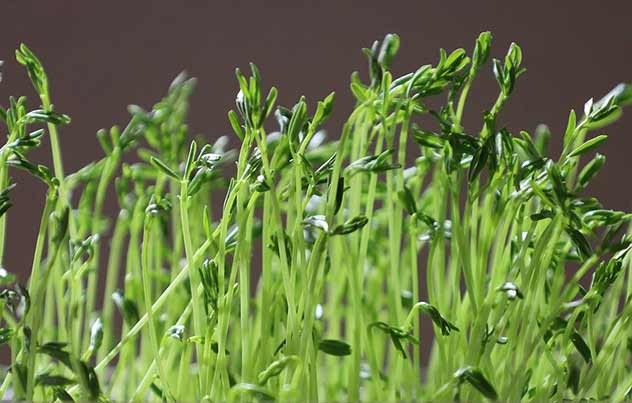Spring tends to be the time when every enthusiastic gardener or cook gets sowing and growing multiple seeds. This includes growing sprouts and growing microgreens because they are so easily germinated in your kitchen and/or on the window sill in small containers and jars.
There are a few things to consider before you start buying seeds and let them develop in order to be successful. This depends on multiple factors.
What are the differences between sprouts and microgreens?
- Growing method and medium:
Sprouts are germinated from seeds in just water in a mason jar that is turned and the water is replaced.
Microgreens are grown in potting compost or a similar growing medium in a tray. - Time to harvest:
Sprouts are super fast and can be ready in as little as 2-5 days! It depends on the seed how fast they grow.
Microgreens take longer to get ready to be eaten, it takes typically 6 -8 days or longer. - What you eat:
You can eat the entire seedling of sprouts, including the seed itself, however you discard the non germinated seeds.
With microgreens, you harvest the first true leaves and stem by cutting them with a knife or a pair of scissors. - Flavour and texture:
Sprouts tend to have a milder flavor and a more delicate, crunchy texture.
Microgreens pack a more concentrated punch of flavor and come in a wider variety of textures depending on the type.
Which foods get elevated by an addition of Sprouts and Microgreens?
Sandwiches, salads, soups, stir fries and smoothies are enriched with these nutrient rich greens.
Which seeds can be used for Sprouting and Microgreen growing or both?
There’s actually some overlap between seeds that work well for sprouting and those that are good for microgreens! I’m personally growing lentils and radish in mason jars at the moment.
In general you could follow this recommendation.
Common names, botanical names and suitability of the way of growing. The below table lists the suitability of seeds to grow using a certain method.
Common Name |
Botanical Name |
Method of Growing |
| Mung Beans | Vigna radiata | Sprouting/ Microgreens |
| Chickpeas | Cicer arietinum | Sprouting/ Microgreens |
| Lentils | Lens culinaris | Sprouting/ Microgreens |
| Green Peas | Pisum sativum var. saccharatum |
Sprouting/ Microgreens |
| Snow Peas | Pisum sativum var. macrocarpum | Sprouting/ Microgreens |
| Broccoli | Brassica oleracea var. italica | Sprouting/ Microgreens |
| Radish | Raphanus sativus | Sprouting/ Microgreens |
| Arugula / Rocket | Eruca sativa | Sprouting/ Microgreens |
| Cabbage | Brassica oleracea var. capitata | Sprouting/ Microgreens |
| Alfalfa | Medicago sativa | Sprouting |
| Clover | Trifolium spp. | Sprouting |
| Fenugreek | Trigonella foenum-graecum | Sprouting |
| Sunflower | Helianthus annuus | Better for sprouting, Microgreens |
| Beets (sprouts can be bitter) | Beta vulgaris | Microgreens |
| Basil | Ocimum basilicum | Microgreens |
| Sunflower | Helianthus annuus | Microgreens |
| Dill | Anethum graveolens | Microgreens |
| Cilantro | Coriandrum sativum | Microgreens |
| Parsley | Petroselinum crispum | Microgreens |
| Kale | Brassica oleracea var. sabellica | Microgreens |
| Kohlrabi | Brassica oleracea var. gongylodes | Microgreens |
Important note:
- For sprouting, look for sprouting seeds specifically. These are often treated to prevent bacterial growth.
- It is always a good idea to choose organic seeds.
- If you are not sure whether to buy a particular seed, try searching online to see if others have had success sprouting or growing it as microgreens.

